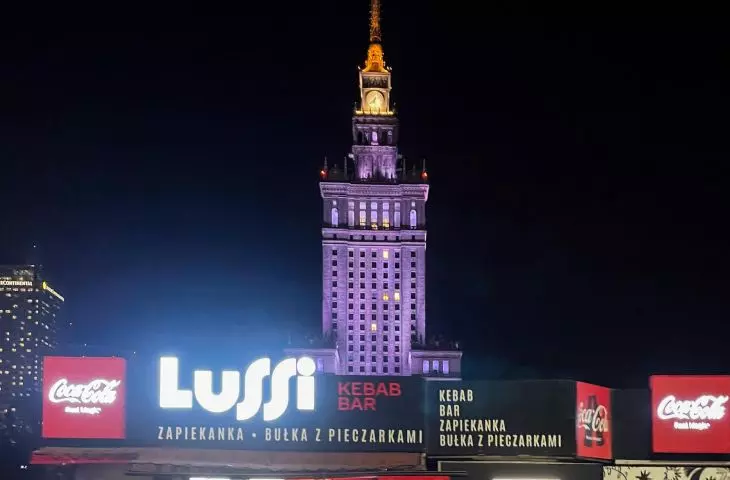Since 1991, in the central point of Warsaw, on the axis of the Palace of Culture and Science, symmetrically between the two pavilions of the Warszawa Śródmieście station, stands it - the Lussi casserole stall. The news of the planned demolition of the monument to early capitalism electrified Varsovians. 17,000 people are interested in participating in an event organized in its defense.
Although Defilad Square has been filled with similar structures over the years, Lussi is one of the last vestiges of the frenetic 1990s in this space. Standing at the foot of the Palace of Culture, the kiosk has been serving Varsovians and numerous travelers with zapiekanki continuously since 1991. While the location of the kiosk remains the same, its form has evolved. From a patchwork of several modular yugoks, through a distinctive red signboard with yellow lettering, to a contemporary, more elegant version with a slightly subdued color scheme.
Warszawa Śródmieście station and Lussi booth
Photo: Wistula | © Wikimedia Commons CC BY-SA 4.0 DEED
Warsaw's favorite zapiekanka, despite its long tradition and a number of modernizations carried out, remains an illegal structure. As Sebastian Rymbiewski, the owner, explained to Gazeta Wyborcza - the structure cannot be legalized due to its contradiction with the current Local Development Plan. The Municipal Road Administration, in turn, points out that Lussi illegally occupies part of the road lane, which has been in effect since 2010. On this basis, every year the ZDM charges business owners with penalties amounting to ten times the rate for legal occupation of the land - an annual amount of about PLN 70,000. Previously, Lussi operated under an agreement with ZDM. This year, the owner lost before the Local Government Appeals Board, which usually overturned the fines. After more than three decades of operation, Lussi is facing demolition.
The news of the end of the iconic bar electrified residents of Warsaw. As a gesture of support for the owners, the Luzztro club and Kacper Ponichtera are organizing a Rave under the Lussi bar on March 9. As the organizers point out on the Facebook event page, the event is peaceful and in support of the legendary bar. Rafal Trzaskowski also received an invitation. The arrival of the Warsaw mayor is somewhat doubtful, but the huge interest in the protest action is undeniable. 1,800 people have declared their participation in the event, and another 17,000 are interested. In addition to music and dancing, guests at the Lussi bar will also be treated to the world's largest casserole, which is expected to break the current Guinness record of 108 meters.
© Facebook Gawęda Warszawska
The disappearance of the stall, however, does not mean the end of the iconic zapiekanka. The business is to move to one of the pavilions of the Warszawa Śródmieście station. As now, food is to be served from a window, and the name will also remain unchanged. In 2025 the reconstruction of the cross-city railroad route, which has been postponed for years, is to begin, and with it Jerozolimskie Avenue - then the booth would probably have to disappear anyway. So why all the fuss?
The Lussi case shows how complex the issue of public spaces is. It is not always what is nice and presentable that is of value to the local community. Often it is the temporary structures that turn out to have the strongest impact on the collective consciousness. A similar mechanism worked in 2012 during the defense of the Press Bar. The then mayor of the district, Wojciech Bartelski, claimed that the prestigious city center was no place for this type of activity, which sparked fierce protests and even an occupation of the premises.
Dotleniacz, an installation by Joanna Rajkowska, on Grzybowski Square in Warsaw.
Photo: Adrian Grycuk | © Wikimedia Commons CC BY-SA 3.0 pl
A slightly different case was Joanna Rajkowska 's Dotleniacz installation on Grzybowski Square. Although it's hard to compare a casserole stall to an art installation, its casual, semi-wild and even slightly overdone character determined the success of the action. The later, final development of the square with elegant benches and stone floors lacks the value of familiarity. Although the space is representative - it lacks room for spontaneity. Warsaw's Downtown is becoming depopulated - in 10 years the district has lost 20,000 residents. This makes it all the more crucial for the City to have a responsible housing policy, housing and incentives for local entrepreneurs, increasingly pushed out of the center of the capital by large chains. A livable Downtown must have a diverse offer, not just posh, prestigious or chain establishments and stores. And while not every booth is worth protecting, and public spaces need redevelopment, this should not happen at the expense of local identity.




















